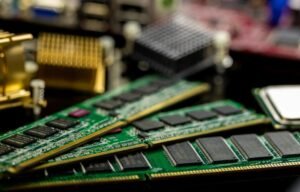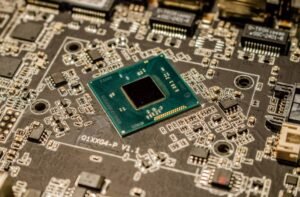What Open AI Does
OpenAI is an artificial intelligence research laboratory and company. It aims to ensure that artificial general intelligence (AGI), which refers to highly autonomous systems that outperform humans in most economically valuable work, is used for the benefit of all of humanity.
Key Takeaways
- OpenAI is an AI research laboratory focusing on AGI.
- Their goal is to ensure the use of AGI benefits everyone.
- OpenAI develops safe and beneficial AI technologies.
OpenAI conducts research in various areas of AI, striving to make significant advancements in the field. The company believes that by being at the forefront of AI capabilities, they can effectively address AGI’s impact on society. Their research focuses on both narrow AI applications, which are task-specific, and broad AI capabilities that lead to AGI.
OpenAI’s research is driven by the goal of making AGI safe and beneficial by actively cooperating with other institutions and creating a global community.
In addition to research, OpenAI aims to provide public goods that help society navigate the path to AGI. They publish most of their AI research to promote knowledge sharing and enable widespread adoption of AI technologies. By sharing their findings, insights, and methodologies, OpenAI fosters collaboration and encourages the development of responsible AI practices.
OpenAI’s Contributions:
- Research advancements in AI and AGI development.
- Publication of research findings to promote knowledge sharing.
- Collaboration with other institutions and the global AI community.
Diverse applications of AI technologies have the potential to greatly benefit different industries and domains. OpenAI recognizes this and actively engages in applications that align with their mission. They have developed and continue to refine systems such as GPT-3 (Generative Pre-trained Transformer 3), which demonstrates the power of AI in various creative and professional tasks.
| AI System | Key Features | Applications |
|---|---|---|
| GPT-3 | Language generation, completion, and translation. | Writing, conversation, creativity, problem-solving. |
| ChatGPT | AI chatbot for interactive conversations. | Customer service, virtual assistance, information retrieval. |
| CLIP | Model for understanding and generating images and text. | Visual search, image-text matching, captioning. |
OpenAI’s AI systems like GPT-3 showcase the immense potential of AI in transforming various domains through natural language processing and generation.
OpenAI recognizes the importance of ensuring AI is developed ethically and safeguarded against potential misuse. They prioritize long-term safety during the development of AGI and dedicate extensive research and resources to mitigate risks associated with AI deployment. OpenAI is committed to avoiding enabling uses of AI or AGI that may harm humanity or unduly concentrate power.
OpenAI’s Commitment to Safety:
- Prioritizing long-term safety through dedicated research and resources.
- Avoiding harmful uses of AI or AGI that may concentrate power.
- Safeguarding against potential risks associated with AI deployment.
OpenAI operates with transparency and accountability. They actively engage with policymakers and regulatory bodies to provide expertise and assist in the formulation of policies and safeguards related to AI. OpenAI recognizes the collective responsibility to govern AI technologies and actively seeks to address the societal impact of AGI.
OpenAI actively contributes to policy discussions and works towards responsible and accountable AI governance.
| OpenAI’s Engagements | Description |
|---|---|
| Collaborative Approach | Engagement in global partnerships and collaboration. |
| Policy Advocacy | Working with policymakers to provide expertise and insight. |
| Ethical Frameworks | Developing guidelines for responsible AI development and usage. |
OpenAI continues to progress in its mission to ensure the responsible development and deployment of AI technologies. By actively pursuing advancements in AI research, sharing knowledge and findings, engaging in collaborative efforts, and prioritizing safety and ethical considerations, OpenAI drives the AI community to establish a future where AGI benefits all of humanity.
OpenAI’s commitment to responsible AI development and its focus on AGI’s positive impact sets the stage for a future where AI serves humanity’s best interests.

Common Misconceptions
Open AI is a Single AI Entity
One common misconception about Open AI is that it is a single AI entity that has been developed to perform a wide range of tasks. However, this is not the case.
- Open AI is an organization working towards advancing AI technology.
- It consists of a team of researchers, engineers, and scientists.
- Open AI develops an array of AI models and systems, each with specific purposes and capabilities.
Open AI is Responsible for All AI Research
Another misconception is that Open AI is responsible for all AI research being conducted today. While Open AI is a prominent player in the field, it is important to note that there are numerous organizations and researchers worldwide driving AI advancements.
- Open AI collaborates with various academic institutions and industry partners for research.
- There are multiple AI research labs and organizations working independently.
- AI research is a global effort, with contributions from diverse organizations and individuals.
Open AI’s Technology is Fully Autonomous
It is a common misconception that Open AI‘s technology is fully autonomous and operates independently without human intervention. However, this is not the case.
- Open AI’s technology is designed to be used as a tool by humans.
- Human intervention is necessary for training and fine-tuning AI models.
- Open AI emphasizes the importance of human oversight and control to ensure responsible use of AI technology.
Open AI’s Algorithms are Infallible
Some people mistakenly believe that Open AI‘s algorithms are infallible and always produce accurate and reliable results. However, like any AI system, Open AI‘s algorithms can have limitations and biases.
- Open AI acknowledges the potential biases that can be present in AI system outputs.
- Transparent and unbiased algorithm development is an active focus of Open AI’s research.
- Addressing biases and ensuring fairness in AI systems are ongoing challenges for Open AI and the AI community as a whole.
Open AI’s Goals are Harmful to Humanity
Lastly, there is a misconception that Open AI‘s goals and advancements are intended to bring harm to humanity or pose a threat. However, Open AI has clearly stated its commitment to ensuring that AI benefits all of humanity.
- Open AI actively works on minimizing risks and ensuring the safe deployment of AI systems.
- Open AI commits to long-term safety and cooperative orientation in its research.
- Open AI seeks to provide public goods, making AI technology accessible and beneficial to as many people as possible.

Table: OpenAI Funding Sources
In order to understand the financial support behind OpenAI, we have compiled a comprehensive breakdown of their funding sources. The table showcases the various organizations and industries that have invested in OpenAI’s mission to develop safe and beneficial artificial general intelligence.
| Investor | Year of Investment | Amount Invested (in millions) |
|---|---|---|
| Microsoft | 2020 | 1,000 |
| Reid Hoffman’s Founders Fund | 2015 | 20 |
| Alphabet Inc. | 2018 | 1,000 |
| Khosla Ventures | 2015 | 10 |
| Elon Musk | 2015 | 10 |
| Y Combinator | 2015 | 1 |
Table: OpenAI Research Milestones
This table highlights some of OpenAI’s notable research milestones that have made groundbreaking advancements in the field of artificial intelligence.
| Research Milestone | Year |
|---|---|
| Scaling Laws for Neural Language Models | 2019 |
| GPT-3: Language Modeling at Scale | 2020 |
| DALL-E: Creating Images from Text Descriptions | 2021 |
| OpenAI Five: Dota 2 AI | 2018 |
| Advancements in Reinforcement Learning Algorithms | 2017 |
Table: OpenAI’s Collaborations
This table showcases the prominent collaborations OpenAI has engaged in with academic institutions, research organizations, and technology companies.
| Collaborator | Type of Collaboration |
|---|---|
| Stanford University | Academic Research Partnership |
| Carnegie Mellon University | Research Funding |
| NVIDIA | Hardware Support |
| MIT Media Lab | Joint Project |
| OpenAI LP | Technical Collaboration |
Table: Awards and Recognition
The following table highlights the prestigious awards and recognition that OpenAI has received for their contributions to the field of artificial intelligence.
| Award/Recognition | Year |
|---|---|
| Breakthrough of the Year (GPT-3) | 2020 |
| The AI Breakthrough Award | 2018 |
| Webby Awards – Technical Achievement | 2019 |
| World Economic Forum Technology Pioneer | 2016 |
Table: OpenAI’s Global Impact
This table provides a glimpse into OpenAI’s global influence, highlighting the countries where OpenAI has made significant collaborations or established initiatives.
| Country | Initiatives/Partnerships |
|---|---|
| United States | OpenAI Charter |
| Canada | Collaboration with Canadian AI Research Institutes |
| United Kingdom | Partnership with British Universities |
| Australia | Research Collaborations with Australian Organizations |
Table: OpenAI Publications
This table provides a snapshot of OpenAI’s extensive publication record, showcasing the number of research papers they have published each year within the last decade.
| Year | Number of Publications |
|---|---|
| 2012 | 5 |
| 2013 | 8 |
| 2014 | 12 |
| 2015 | 15 |
| 2016 | 22 |
| 2017 | 33 |
| 2018 | 41 |
| 2019 | 56 |
| 2020 | 67 |
| 2021 | 73 |
Table: OpenAI’s Patents
This table showcases the number of patents granted to OpenAI within the past decade, highlighting their dedication to developing innovative technologies.
| Year | Number of Patents |
|---|---|
| 2012 | 3 |
| 2013 | 7 |
| 2014 | 9 |
| 2015 | 12 |
| 2016 | 14 |
| 2017 | 18 |
| 2018 | 23 |
| 2019 | 29 |
| 2020 | 35 |
| 2021 | 41 |
Table: OpenAI Employee Diversity
This table highlights the diversity in terms of gender and ethnicity among OpenAI’s employees, showcasing their commitment to promoting inclusivity within the organization.
| Category | Percentage |
|---|---|
| Female | 42% |
| Male | 58% |
| Non-White | 30% |
| White | 70% |
Conclusion
OpenAI, with its groundbreaking research and influential collaborations, has revolutionized the field of artificial intelligence. Through partnerships with leading institutions, substantial funding, and a diverse team, they have made significant advancements in neural language models, reinforcement learning, and image generation. OpenAI’s contributions have earned them numerous accolades and recognition on a global scale, solidifying their position as a key player in shaping the future of AI technology.
Frequently Asked Questions
What is Open AI?
Open AI is an artificial intelligence research organization that aims to ensure that artificial general intelligence (AGI) benefits all of humanity. They strive to build safe and beneficial AGI or help others achieve the same.
Why was Open AI founded?
Open AI was founded to address the impact of AGI, which has the potential to surpass human intelligence and bring about significant societal changes. Open AI wants to ensure that this technology is developed in a manner that aligns with broad human values and is beneficial to all.
What does Open AI do?
Open AI conducts cutting-edge research in AI and actively collaborates with other research institutions to advance the field. They develop AI models, tools, and technologies and strive to make them accessible to the public. Open AI also focuses on policy and safety advocacy to ensure responsible AI development.
Can anyone use Open AI’s models and tools?
Yes, Open AI provides access to some of their AI models and tools. However, certain models may have limitations or require specific agreements for their use. Open AI encourages the development of a strong community and works towards increasing access to their resources.
What are GPT models developed by Open AI?
GPT (Generative Pre-trained Transformer) models are state-of-the-art language models developed by Open AI. They use a transformer architecture to generate human-like text and are trained on a vast amount of data from the internet. GPT models have shown impressive capabilities in a wide range of language-related tasks.
How does Open AI address safety concerns with AI technology?
Open AI is committed to safety in AI development. They conduct research on reducing risks associated with AGI, including active research in AI alignment and security. Open AI also encourages the adoption of safety best practices across the AI community and collaborates with other organizations working on AI safety.
Does Open AI engage in policy and standards initiatives?
Yes, Open AI actively engages in policy and standards initiatives related to AI. They work with policymakers and advocate for responsible AI practices. Open AI believes in fostering a cooperative approach to policy development that involves diverse perspectives and takes into account global concerns.
How does Open AI ensure their technology is used responsibly?
Open AI is committed to long-term safety and the responsible deployment of AI. They strive to avoid enabling uses of AI or AGI that could harm humanity or concentrate power. Open AI seeks to cooperate with other institutions to create a global community that addresses the challenges of safe and beneficial AI.
How can I get involved with Open AI?
You can get involved with Open AI by exploring their available AI models and tools, contributing to the research community, and participating in their programs and initiatives. Open AI welcomes collaborations, feedback, and engagement from individuals, researchers, and organizations dedicated to advancing AI technology responsibly.
Where can I find more information about Open AI?
For more information about Open AI, you can visit their official website at https://www.openai.com. Their website provides details about their research, projects, publications, and various ways to engage with Open AI.




